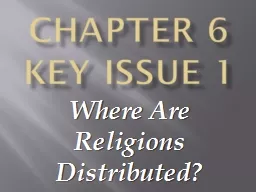

Geographers distinguish two types of religions 1 UNIVERSALIZING religions that attempt to be GLOBAL by appealing to all people not just those in a particular location ID: 676805
Download Presentation The PPT/PDF document "Chapter 6 Key Issue 1 Where Are Religion..." is the property of its rightful owner. Permission is granted to download and print the materials on this web site for personal, non-commercial use only, and to display it on your personal computer provided you do not modify the materials and that you retain all copyright notices contained in the materials. By downloading content from our website, you accept the terms of this agreement.
Slide1
Chapter 6Key Issue 1
Where Are Religions Distributed?Slide2
Geographers distinguish
two types
of
religionsSlide3
1.)
UNIVERSALIZING
religions
that
attempt
to be
GLOBAL by
appealing to all
people, not just those in a particular location
.Slide4
58%
of the world
’
s population practices a universalizing religion.Slide5
The LARGEST THREE Universalizing religions are-
Christianity
– 2.1 billion adherents
Islam
– 1.5 billion adherents
Buddhism
– 376 million adherentsSlide6
2.)
Ethnic religions
appeal primarily to one group of people living in one place
.Slide7
26%
of
world
’
s population practices an ETHNIC religion
.Slide8
The LARGEST Ethnic religions are-
HINDUISM
– 900 million adherents
CHINESE TRADITIONAL (Confucianism/Taoism)
- 394 million
ASIAN PRIMAL-INDIGENOUS
– 300 million
AFRICAN TRADITIONAL
– 100 millionSlide9Slide10Slide11
16%
of the Earth’s population is
nonreligious
, either rejecting religion or simply not taking part in it.
ATHETISTS
reject the existence of God altogether
AGNOSTICS reject that anything can truly be
known
about God- “I don’t know, and neither do you”Slide12
UNIVERSALIZING
religions tend to be internally divided into
BRANCHES, DENOMINATIONS,
and
SECTSSlide13
A
branch
is a large and fundamental division within a religion
Examples include
:
CHRISTIANITY
–
CATHOLIC / PROTESTANT/ ORTHODOX
ISLAM
–
SUNNI v. SHIITESlide14
A
denomination
is a division of a branch that unites a number of
congregations in a single legal and administrative body
PROTESTANT
=
Baptist, Episcopal, Congregational, Lutheran, Methodist, Pentecostal…
BAPTIST
=
Southern, NBC USA/America, Nat’l Missionary Baptist, Progressive Nat’l…Slide15
A
sect
is a relatively small group that has broken away from an established
denomination.Slide16
DENOMINATIONS & DISTRIBUTION OF UNIVERSALIZING RELIGIONSSlide17
BRANCHES OF CHRISTIANITY
)
Roman Catholic
(
51
% of world
’s Christians)
)
Protestant
(
24
% of world
’
s Christians)
)
Orthodox
(
11
% of world
’
s Christians) Slide18
DISTRIBUBUTION
OF
CHRISTIANITYSlide19
Christianity in Europe
Roman Catholicism
southwestern and eastern Europe.
Protestantism
northwestern
Europe.
Orthodoxy
eastern
and southeastern Europe.Slide20Slide21
Christianity in the Western Hem.
93% of Christians in Latin America are Roman Catholic.
Only
40% in North AmericaSlide22Slide23Slide24
Protestant churches have approximately
82
million
US members
Baptist
churches have largest number of US adherents (37 million
), mostly in the South.
Other Christian denominations such as
Lutherans
,
Mormons
, and
Methodists
also have significant geographic concentrations.Slide25
DISTRIBUTION OF ISLAMSlide26Slide27
2 Main Branches of ISLAM-
SUNNI
– 83% of Muslims
SHIA
(SHIITE) – 17% of MuslimsSlide28
SUNNIS are evenly dispersed throughout the Islamic world.
SHIA are highly concentrated in Iran and surrounding countries, as well as in Syria and Yemen.Slide29Slide30
Three branches of BUDDHISM
1.)
Mahayana
– 56% of Buddhists
2.)
Theravada
– 38%
3.)
Vajrayana
– 6%Slide31Slide32Slide33
ETHNIC RELIGIONS
Often remain within the culture where they originated.
Have more clustered distributions than do universalizing religions.
Often do not widely attract adherents from other cultures.Slide34
Ethnic religion with largest number of followers is
HINDUISM
.
900 million adherents
Nearly all concentrated in India and NepalSlide35Slide36
RELIGIONS OF ASIA
All three UNIVERSALIZING religions form the majority in some Asian countries.
Christianity
: the Philippines
Islam
: Indonesia & Malaysia
Buddhism: Many continental countries (also Japan)Slide37Slide38
Nearly 400 million Chinese practice either Confucianism or TaoismSlide39
300 million people throughout Asia practice ‘primal-indigenous’
religions.
Most of these lack a literary tradition and are transmitted ORALLYSlide40
Religion in AFRICA
Like in Asia, universalizing religions dominate in most countries, though ethnic religions continue to exist in remote places.Slide41Slide42
Animists
believe
that inanimate objects or natural
events- like natural disasters- have spirits and conscious life.
100 million
Africans adhere to animism.Slide43
As universalizing religions have expanded, ethnic religions have begun to disappear
in AfricaSlide44
An Ethnic Outlier: Judaism
Though it has deeply influenced both Islam and Christianity, Judaism is a decidedly ETHNIC religion. Slide45
The world’s first MONOTHEISTIC
religion
W
orld’s
12 million Jews
are highly clustered
, almost exclusively found in
Israel (2/5)
and the United
States (2/5).
Unlike Islam and Christianity, Judaism is
not
a
PROSELYTIZING religion
, meaning its adherents
do not
actively promote the conversion of others.